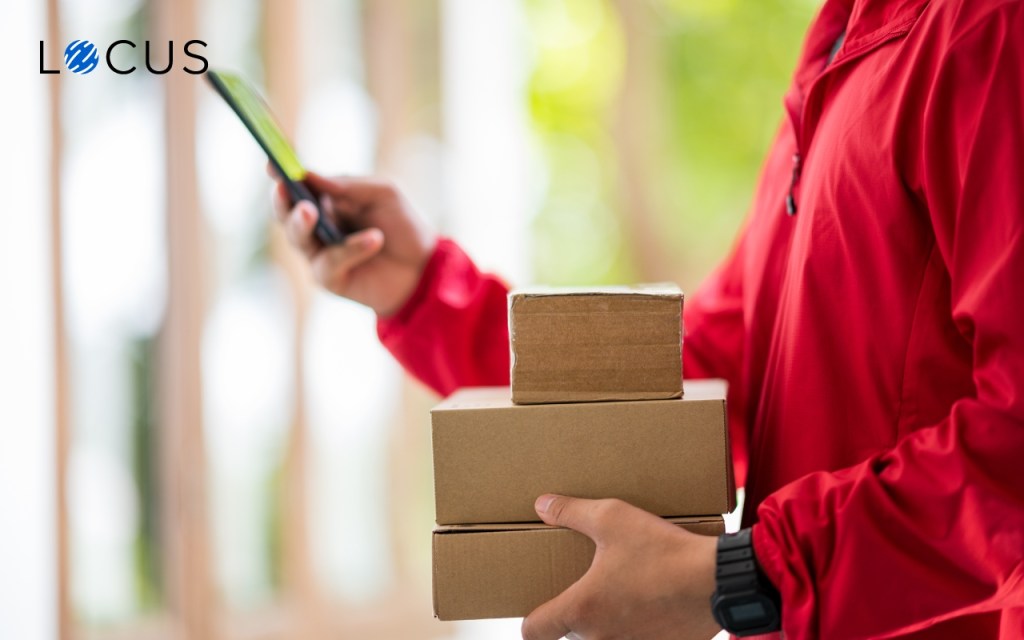Last Mile Delivery Optimization, Route Optimization
How Delivery Logistics Software Improves On-Time In Full (OTIF) Delivery Score
May 21, 2021
12 mins read

Amongst shippers, 51% told us that a lack of clarity on customer demand was the biggest bottleneck emerging as a result of COVID-19. – Emerging out of the Pandemic Supply Chain Report, Reuters Events, Oct 2020
The ability to fulfill customer needs, by delivering goods at the right place and time, determines the efficiency of a delivery business. Delayed deliveries slow down supply chains and hurt customer relationships, thereby affecting the company’s reputation.
With increasing customer demand and rising pressures from competitors due to COVID-19, maintaining on-time delivery performance has become challenging.
Businesses that are inconsistent in fulfilling their on-time delivery promises cannot offer positive customer experiences. Hence, they should focus on enhancing an essential metric called On Time In Full (OTIF) Delivery.
What is On-Time and In-Full Delivery (OTIF)?
On Time In Full delivery is a metric to explain if the customer gets everything they ordered on the day they expected to receive it. It measures whether a company was able to deliver a full quantity of products to the customer at the requested time. It is a measure of the effectiveness of a company’s supply chain, also called DIFOT (Delivery In-full, On-Time)
OTIF or DIFOT generally covers the entire supply chain. It is used during different stages of a supply chain that is preceded by the activity it describes.
Ex: Supplier OTIF, Dispatch OTIF, Picking OTIF, Delivery OTIF, Receipt OTIF, and Delivery OTIF. Though OTIF is used throughout the supply chain, it majorly corresponds to delivery performance in it.
A Breakdown of OTIF
The two different metrics that make up OTIF are described as following:
On Time: A service metric that tracks how close a business meets its highly agreed-upon delivery appointment time. It measures the capability of an organization to meet customer demand in terms of the requested delivery date.
In Full: It measures whether the customers are receiving the exact quantity of product they requested.
Formula to Find the OTIF metric
OTIF (%) = (Number of deliveries made on time and in full ÷ Number of total deliveries) x 100
OTIF combines the timeliness of delivery and completeness of order. It is the percentage of shipments delivered on-time correctly versus all shipments sent.
On-Time In Full Delivery Score is usually stated as a percentage that analyzes how well an inventory stock was sent out and delivered. An OTIF score of 89% means 89 out of 100 deliveries from your inventory stock have reached customers on time.
What are the reasons for delivery delays?

Before knowing the importance of OTIF, it is necessary to understand the reasons for delivery delays. Understanding the causes of delivery delays helps logistics businesses improve their efficiency and provide a delightful customer experience. The reasons for delivery delays include:
Incorrect addresses
A delivery attempt remains unsuccessful if customers do not provide all necessary details. Wrong addresses make it difficult for fleet drivers to deliver the products to customers. This either results in failed deliveries or missed deliveries, adding up the costs of your delivery.
Failed deliveries
Field service professionals have to deal with a large number of delivery parcels daily.
A delivery attempt becomes unsuccessful if a customer is not available in that delivery location. In such cases, the delivery company cannot return the parcel to this address on the same day. Also, drivers cannot wait long for the customers to receive their orders as it will lead to delays in shipping other packages.
Peak delivery schedules
Logistics companies have to deal with a large number of parcel volumes during peak shopping seasons. They should deal with both operational constraints and business constraints during this season. Shortage of drivers, lesser vehicle capacity, or some other issues make their on-time delivery commitments challenging.
Peak delivery shopping seasons force drivers to work under tight delivery schedules. A small delay in delivery to one location can affect other deliveries in the schedule.
Traffic restrictions
Unexpected traffic delays harm on-time delivery promises of delivery companies. Traffic diversions result in drivers traveling long distances between delivery stops. They increase idling costs, leading to a rise in fuel consumption and transportation costs.
Lack of visibility
Safe and timely deliveries are determined by ensuring clear visibility. A lack of visibility makes an organization victim to numerous inefficiencies causing damage, delays, and loss of shipment.
Lost packages
Frustrated customers enquire about the current status of their packages frequently. Packages get lost due to simple misplacement, damaged shipping labels, etc. Increasing package thefts cause a huge headache for delivery companies and minimizes First Attempt Delivery Rate (FADR).
Vehicle issues
With the recent rise in online shopping demand driven by COVID-19, logistics businesses are facing increased fleet capacity burdens. This has resulted in unexpected vehicle breakdowns leading to few hours of delivery delays. Businesses find it challenging to fulfill their on-time delivery promises when there are frequent vehicle breakdowns.
No investment in the right technology
48% of shippers and 49% of LSPs (Logistics Service Providers) are accelerating their technology roadmap. Coupled with the increase in spending, it is clear that this pandemic has had a direct impact on technology budgets and implementation. -Emerging out of the Pandemic Supply Chain Report, Reuters Events, Oct 2020
Without a well-directed investment in the right technology, it becomes difficult for a business to mitigate shipment delays. The use of old model software or antique software limits the ability to integrate new technology leading to delivery inefficiencies.
Unusual situations
Of the 202 shippers we surveyed, the average score they gave their companies for preparedness for a shock on the scale of COVID-19 was 60/100. Among the 200 Logistics Service Providers (LSPs) the mood has been similar, telling us that their industry was only moderately prepared for COVID-19, scoring an average of 63/100. – Emerging out of the Pandemic Supply Chain Report, Reuters Events, Oct 2020.
Unusual situations like the COVID-19 pandemic have led to a meteoric rise in online shopping demand. During the early pandemic days, companies found it tough to accommodate this sudden increase in demand. Presently, they are adapting themselves to this change.
Though customers have become lenient with respect to fast delivery options, they do not want to give up on the on-time delivery promise. Unusual situations test the on-time delivery standards of various businesses. Businesses that are resilient to these disruptions broaden their customer base like never before.
Why is it necessary to improve the On Time In Full (OTIF) Delivery Score?
Even a business that has the most unique product in the world cannot succeed if it does not deliver its products on-time. Offering on-time deliveries may seem very basic, but forms the rock-solid foundation on which successful businesses are built. Here are reasons to focus and improve on OTIF scores.
Increase loyal customers
One bad review from a customer can spoil your business’s reputation today. Customers select their services after getting recommendations from friends, family, and search engine reviews. They take their businesses to your competitors if they don’t receive deliveries on time
A company should not compromise on its huge customer base by being complacent in its on-time delivery performance. If you have earned a good name through on-time deliveries, you get repeat customers. Once the repeat customers become your loyal customers, they bring in new customers through word-of-mouth and referrals.
Making proper on-time deliveries ensures that your customers don’t move away even if you have charged higher prices than your competitors.
Reduce last-mile delivery costs
Missed deliveries add more burden to drivers, as they have to make up for it. The pressure to fulfill on-time deliveries of large parcel volumes leads to rash driving causing road mishaps. These road mishaps incur costs through repairs, medical expenses, and legal expenses that ruin your business.
The inability to deliver products on-time causes repeated deliveries, doubling up fuel expenses. Improving on-time delivery performances help companies accommodate more deliveries, creating additional earning opportunities. It enables fleet managers to reduce operational expenses without burdening the existing workforce as well.
Minimize delivery delays
Delivery delay is the biggest threat for online businesses today. It has become necessary to reduce the repeated occurrence of delivery delays for all businesses.
On Time In Full metric helps fleet managers to calculate delivery delays and devise the right strategies to counter them. It helps them downsize or upsize their fleet assets to match the existing customer demand.
Improve driver safety and fleet performance
In order to fulfill on-time delivery goals, drivers commit rash driving leading to accidents or vehicle issues in the long term.
On Time In Full Delivery metric helps logistics managers track if drivers have made on-time deliveries through rash driving. It helps them monitor the vehicle’s health and driver performance and provides crucial insights. These insights help them easily assign the upcoming delivery tasks and enhance their driver performance.
How delivery logistics software improves your On-Time and In-Full (OTIF) Delivery score

65% of shippers have either slightly or significantly increased their eCommerce operations due to COVID-19. – Emerging out of the Pandemic Supply Chain Report, Reuters Events, Oct 2020
The present COVID-19 scenario has added an increased emphasis on on-time delivery performance. An investment in technology like delivery logistics software helps businesses to adapt their delivery schedules and fleet assets to varying customer demands. Here’s how a delivery logistics software enhances OTIF scores of logistics businesses.
Accommodate preferred delivery slots
Some customers may want their orders delivered within the same day by 4 o’clock. But some of them may demand their orders after two or three days. It is necessary to prepare a delivery schedule that accommodates thousands of deliveries with different order priorities and assign them to drivers.
With multiple clashing order priorities, it becomes difficult for a fleet manager to prepare optimal delivery schedules for all drivers. An improperly planned delivery schedule makes it challenging for drivers to maintain their efficiency standards.
A delivery logistics software helps businesses organize their delivery schedule by setting order priority. It helps them identify delivery stops that must be served based on the order’s importance or the specified calendar date. It enables them to schedule their order priorities flexibly even if there are any resource constraints.
Plan optimal routes
The growing customer demand has forced businesses to deal with large parcel volumes and heavy traffic congestion. Beyond all delivery constraints like vehicle capacity, driver skill sets, etc, heavy traffic restrictions affect on-time deliveries.
Delivery logistics software plans optimal routes that ensure drivers pass through roads with the least idle time. It helps drivers avoid lost fuel and time due to worsening traffic conditions. It automates new route plans in seconds if there are last-minute delivery changes, thereby improving on-time delivery performance.
Analyze delivery performance
Elon Musk says that the biggest concern for him in business is to set a corrective feedback loop. In logistics, this corrective feedback loop is not possible without past delivery performance data. Delivery logistics software provides crucial insights on delivery performance like:
- Waiting time
- Fuel consumption
- Idling costs
- Cost per mile
- Order accuracy
- Unnecessary stoppages and breaks
- Hours in motion
- Total mileage
- Planned routes vs actual routes
- Capacity utilization and so on
Analyzing this delivery information helps fleet managers design strategies that improve driving performance. Also, these data points come in handy for delivery logistics software to create delivery schedules that fulfill on-time delivery promises effectively.
Real-time tracking of ongoing deliveries
Monitoring ongoing delivery performance helps fleet managers know how well their business copes with new customer demands. On one end, the managers and stakeholders internally need to know what is happening with the current delivery. On the other, customers want a personalized track of their orders during the last-mile.
Real-time tracking is necessary to inform customers about the recent status of their deliveries. It also helps businesses calculate the Expected Time of Arrival (ETA) and effectively manage their delivery slots.
Delivery logistics software helps businesses to communicate each update internally with other stakeholders. It provides customers with alerts and live notifications of all events along the route like delays, detention, attempted delivery, etc. In case of unexpected vehicle stoppages, it enables fleet managers to quickly assign the deliveries to nearby drivers.
As delivery logistics software keeps track of previous on-time delivery performances, it helps fleet managers to plan future delivery schedules effectively, maximizing OTIF scores.
Geocoding to reach the right addresses
Wrong addresses negatively impact the on-time delivery performance of your fleet. With thousands of orders flowing in daily, it becomes difficult to manually correct these mistaken addresses. Rightly mapped addresses are foundational to fulfill on-time deliveries and minimize delivery delays.
Delivery logistics software converts improper addresses into proper geographical coordinates. It helps fleet managers identify delivery territories and create geofences around them. These geofences help them easily assign tasks to drivers and vehicles based on their skill sets and capacity respectively.
Conclusion
Customers require dependable on-time delivery performances to become repeat customers. After fulfilling many on-time delivery promises, repeat customers turn into loyal customers. Tracking the On Time In Full delivery metric with delivery logistics software is the key to winning more loyal customers.
Locus’s Delivery Logistics software helps businesses plan optimal routes and delivery schedules that match the on-time delivery preferences of customers. It helps fleet managers to easily allocate ad-hoc delivery requests to available drivers without burdening them. It enables businesses to monitor and improve OTIF scores, thereby enhancing customer experience.
Reference:
Related Tags:

Sustainability
How Microhubs Contribute Towards Sustainable Urban Freight Logistics
Globally, more people live in urban areas than in rural areas, with 55 percent of the world’s population residing in urban areas in 2018. In 1950, 30 percent of the world’s population was urban, and by 2050, 68 percent of the world’s population is projected to be urban. – World Urbanization Prospects, 2018. Due to […]
Read more
Tech and Product
Logistics is the New Software
Every consumer company WILL be a logistics company. Logistics is the new software. Yes! Let that sink in. The ‘legacy software’ way of running supply chain and logistics is no longer viable for the present ‘on-demand’ world. It needs a new ‘operating system’ to run on. Building such a ‘system’ requires ground-up innovation and first […]
Read moreMOST POPULAR
EDITOR’S PICKS
SUBSCRIBE TO OUR NEWSLETTER
Stay up to date with the latest marketing, sales, and service tips and news


How Delivery Logistics Software Improves On-Time In Full (OTIF) Delivery Score